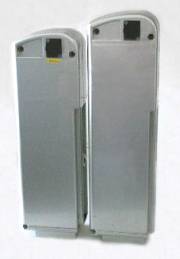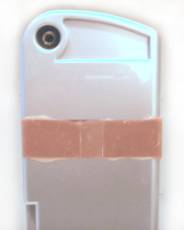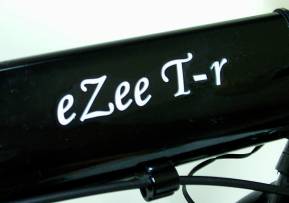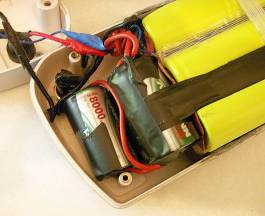Project T bike, the Torq Radical 2

The photo on the right shows two batteries, the left hand one the standard eZee battery, the right hand one the Radical battery. The one on the right is an NiMh one which has been enlarged to take up to three extra cells. Bet you missed this taller battery in the first photo! The reason for this is not speed, which the controller limits despite the extra voltage. It's voltage drop compensation. When placed under high loads as in hill climbing, battery voltage drops and therefore the power drops. Li-ions normally have very constant voltage at normal loadings, but drop very severely under high loads, even to cut out point. NiMh are more variable under normal loads, starting fully charged with high voltage which gradually declines, but under high loadings they don't lose as much so they avoid the problem of cutting out. But I want to improve hill climbing and
this is another way of doing that, providing compensation for the drop by starting with a higher voltage. I toyed with the idea of using a tilt switch to switch in extra cells when the bike started on an incline, but the need to provide external cells and separate charging for them ruled out that attractive idea, the operating complexity being too awkward.
At the right you see the radical battery in it's final form now with three additional cells, bringing it up to 39.6 volts nominal. Two are side by side above the main bank, the third alone at the top which sits behind the charge socket. These cancel the voltage drop when under load without unduly increasing speed. The standard charger stops at 44.6 volts, measured after the battery cools, too high for the controller to accept, but the natural self discharge takes care of that in due course. For when it's required earlier, I've made a small discharger, which plugs into the charger socket

Here you see a stage in enlarging the battery case. To do this I cut the case in half, then rejoined it with the brown gusset seen. Fibreglass is ideal for custom moulding, but is very poor at bonding with most plastic types usd in battery cases. With the eZee case, I used a Dinitrol resin and chopped strand mat premix in a "hot" mix. By this I mean that I used an abnormally high proportion of hardener, this then generating very high setting temperatures, softening the plastic sufficiently to achieve a molecular surface bond. The snag with that is that it sets very quickly, so the layup must be done at speed. To do that, I cut up a Powacycle battery box which is made of an incompatible material that the resin would not bond to, and made up mould
panels for the two sides, attaching them with strong cloth based tape. It went well, with both sides laid up in one operation. The mould panel joins are seen in the photo, but using some body filler on the blemishes fixed that. Then it was a case of finishing the moulding with files and wet and dry paper, car body repair fashion, then spraying with aluminium paint. After hardening a coat of hard clear lacquer finished the job. The join is very strong, the 5.6 kilo battery being able to be carried by the top suspended securely.
Charging is not a problem with additional cells, since the eZee charger's 53 volts quiescent level gives more than adequate headroom to reach the required 44 to 45 volts.
Stripping the bike to it's essentials and fitting lighter parts has substantially reduced it's weight. Actually weighed, not calculated, the T bike with Li-ion battery is now 21.7 kilos, which is down over 11% from the Torq's weight of just over 24.4 kilos, and down by 17% from my previous "on road" weight. With the radical battery the weight is 22.9 kilos, down over 10% from the Torq with the NiMh battery, and down by 15% from the previous "on road" NiMh weight. Some of the weight reductions come from tyres being much lighter, tubes being almost half the weight, carrier weight down by 54%, seatpost down by over 50%, and the removed items like the lights, dynamo, stand and bell.
Performance
On my 9.8 mile hilly test route which climbs to near the top of the North Downs and back, the previous best for the Torq was 19.1 mph average, but on the last run with the T Radical, 9.72 miles was completed in 27 minutes, an average of 21.6 mph, despite it not being still air conditions as previously. From that you might conclude that the T bike has a much faster straight line speed, but in fact that's not much affected. The gains in this new average are mainly from two things, the improved hill climb ability, which was the objective of course, and the much faster downhill performance. Speed is not what the battery modification was about. The voltage increase means the top speed under power in favourable conditions is up from 22 to just over 23 mph, but the real improvement shows in greatly improved hill climbing and the way in which a speed is maintained in other adverse conditions like a headwind. On a very slight up gradient of 2% where speed is usually 18 mph at best, it's now 20 mph, and that 2 mph gain thoughout the range of cicumstances is typical. On hills it has the feel of complete competence.
First the hill climbing. A standard Torq has severely limited power only climbing, only coming to life when assisted, and the most it can handle unaided is a 6% slope very reluctantly. The two percentile point improvement I wanted meant that 1% would be needed from the bike alone, the balance from me via the cycle improvements.
Under test and starting a 7% hill at 11mph with no pedalling, the T bike accelerated and crested the top at almost 16 mph. Delighted with that result, I went on to an 8% which it climbed with ease at a steady 13 mph, and then on to a moderate length 10% which it managed without help, dropping speed but stabilising at 9 mph. I completed this test batch with a longer 10% which it just about managed unaided. Moving from the Radical battery to a Li-ion, the performance was a bit short of that, just able to cope with a very short 10%. These results were gratifying to say the least, since they are right up there with the mainstream medium powered e-bikes and better than many of the lower powered ones.
Moving on to the more normal climbing with pedal assistance, previously I found a short 14% (1 in 7) hill exhausting with the torq's 58" low gear, losing speed during the climb. Now with the T bike using it's 60" second gear, 14% is very easy, seeming much easier than 10% was before, so more than a four percentile gradient improvement. In the 68" third gear, 14% is still comfortable with just a bit more effort, the bike easily kept in the power band above 12 mph.
But it's on the very steepest hills that the improvement is most dramatic. Previously I couldn't entertain a 1 in 5 (20%) hill using the 58" low gear, getting instant cutout of both me and the bike right at the start! Facing an even steeper 1 in 4.5 (22.5%) hill now, and using the 60" second gear, I can climb it with a reasonable 250 watts from me standing on the pedals at around 8 mph. In first gear, I can climb it with ease at 6 mph sitting on the saddle with me contributing much less than 200 watts. This must be the only Torq around that can easily outclimb the Quando and Chopper, the best UK legal hill climbers on the market, which is a complete performance reversal on hills for this model.
Downhill speed is greatly improved due to the tyres and lower air resistance. On a downhill on the test route which consistently produces 31 mph maximum normally from the Torq, the T bike flew down at over 37 mph, followed by an obviously respectful motorist. My top speed record on the Torq on another steeper hill is 41 mph, but this will definitely tumble now, at least 45 mph expected.
The brakes are what's needed for that speed, the rear one very effective due to the extra weight of the motor helping to anchor the tyre to the road, and with both used together the stopping power is easily sufficient to get rammed from behind if the mirror isn't used.
Performance Sources
When I published the Q bike details, there was a lot of speculation in the Pedelecs forum thread about the sources of the improvements, during which some wrong conclusions were drawn. To avoid that this time, here's a complete list of the seven sources of the improvements in the T bike Radical performance, together with explanations. These are primarily in order of importance to hill climbing.
1) One of the most important factors for climbing is weight, so the 17% reduction in the bike, aided by the recently reported reduction of 8 kilos (11%) of my personal weight are important in the hill climb improvement.
2) The better compound, small section, higher pressure tyres greatly reduce the rolling resistance for all conditions including climbing.
3) The voltage drop compensation due to the extra cells. Net motor power is up from approximately 470 watts to approximately 520 watts, gross power up from 576 watts to 634 watts.
4) The wiring from controller to motor shortened by two thirds due to the change in motor position means less electrical supply resistance, increasing motor power.
5) Removal of many accessories like headlight, dynamo, water bottle etc., the reduction of carrier tubes, no mudguard "air brake" and the slim front tyre mean less air turbulence, and the bike being more "slippery" through the air.
6) No more effect from the motor unsprung weight means more forward speed. This energy doesn't come from nowhere, it's derived from road imperfections converting forward driven energy into the vertical energy that causes the discomfort. When the unsprung weight being thrown is high, the forward energy lost is correspondingly high.
7) The improvement in bike efficiency due to the better chain line.
Charging is not a problem with additional cells, since the eZee charger's 53 volts quiescent level gives more than adequate headroom to reach the required 44 to 45 volts.
Stripping the bike to it's essentials and fitting lighter parts has substantially reduced it's weight. Actually weighed, not calculated, the T bike with Li-ion battery is now 21.7 kilos, which is down over 11% from the Torq's weight of just over 24.4 kilos, and down by 17% from my previous "on road" weight. With the radical battery the weight is 22.9 kilos, down over 10% from the Torq with the NiMh battery, and down by 15% from the previous "on road" NiMh weight. Some of the weight reductions come from tyres being much lighter, tubes being almost half the weight, carrier weight down by 54%, seatpost down by over 50%, and the removed items like the lights, dynamo, stand and bell.
Performance
On my 9.8 mile hilly test route which climbs to near the top of the North Downs and back, the previous best for the Torq was 19.1 mph average, but on the last run with the T Radical, 9.72 miles was completed in 27 minutes, an average of 21.6 mph, despite it not being still air conditions as previously. From that you might conclude that the T bike has a much faster straight line speed, but in fact that's not much affected. The gains in this new average are mainly from two things, the improved hill climb ability, which was the objective of course, and the much faster downhill performance. Speed is not what the battery modification was about. The voltage increase means the top speed under power in favourable conditions is up from 22 to just over 23 mph, but the real improvement shows in greatly improved hill climbing and the way in which a speed is maintained in other adverse conditions like a headwind. On a very slight up gradient of 2% where speed is usually 18 mph at best, it's now 20 mph, and that 2 mph gain thoughout the range of cicumstances is typical. On hills it has the feel of complete competence.
First the hill climbing. A standard Torq has severely limited power only climbing, only coming to life when assisted, and the most it can handle unaided is a 6% slope very reluctantly. The two percentile point improvement I wanted meant that 1% would be needed from the bike alone, the balance from me via the cycle improvements.
Under test and starting a 7% hill at 11mph with no pedalling, the T bike accelerated and crested the top at almost 16 mph. Delighted with that result, I went on to an 8% which it climbed with ease at a steady 13 mph, and then on to a moderate length 10% which it managed without help, dropping speed but stabilising at 9 mph. I completed this test batch with a longer 10% which it just about managed unaided. Moving from the Radical battery to a Li-ion, the performance was a bit short of that, just able to cope with a very short 10%. These results were gratifying to say the least, since they are right up there with the mainstream medium powered e-bikes and better than many of the lower powered ones.
Moving on to the more normal climbing with pedal assistance, previously I found a short 14% (1 in 7) hill exhausting with the torq's 58" low gear, losing speed during the climb. Now with the T bike using it's 60" second gear, 14% is very easy, seeming much easier than 10% was before, so more than a four percentile gradient improvement. In the 68" third gear, 14% is still comfortable with just a bit more effort, the bike easily kept in the power band above 12 mph.
But it's on the very steepest hills that the improvement is most dramatic. Previously I couldn't entertain a 1 in 5 (20%) hill using the 58" low gear, getting instant cutout of both me and the bike right at the start! Facing an even steeper 1 in 4.5 (22.5%) hill now, and using the 60" second gear, I can climb it with a reasonable 250 watts from me standing on the pedals at around 8 mph. In first gear, I can climb it with ease at 6 mph sitting on the saddle with me contributing much less than 200 watts. This must be the only Torq around that can easily outclimb the Quando and Chopper, the best UK legal hill climbers on the market, which is a complete performance reversal on hills for this model.
Downhill speed is greatly improved due to the tyres and lower air resistance. On a downhill on the test route which consistently produces 31 mph maximum normally from the Torq, the T bike flew down at over 37 mph, followed by an obviously respectful motorist. My top speed record on the Torq on another steeper hill is 41 mph, but this will definitely tumble now, at least 45 mph expected.
The brakes are what's needed for that speed, the rear one very effective due to the extra weight of the motor helping to anchor the tyre to the road, and with both used together the stopping power is easily sufficient to get rammed from behind if the mirror isn't used.
Performance Sources
When I published the Q bike details, there was a lot of speculation in the Pedelecs forum thread about the sources of the improvements, during which some wrong conclusions were drawn. To avoid that this time, here's a complete list of the seven sources of the improvements in the T bike Radical performance, together with explanations. These are primarily in order of importance to hill climbing.
1) One of the most important factors for climbing is weight, so the 17% reduction in the bike, aided by the recently reported reduction of 8 kilos (11%) of my personal weight are important in the hill climb improvement.
2) The better compound, small section, higher pressure tyres greatly reduce the rolling resistance for all conditions including climbing.
3) The voltage drop compensation due to the extra cells. Net motor power is up from approximately 470 watts to approximately 520 watts, gross power up from 576 watts to 634 watts.
4) The wiring from controller to motor shortened by two thirds due to the change in motor position means less electrical supply resistance, increasing motor power.
5) Removal of many accessories like headlight, dynamo, water bottle etc., the reduction of carrier tubes, no mudguard "air brake" and the slim front tyre mean less air turbulence, and the bike being more "slippery" through the air.
6) No more effect from the motor unsprung weight means more forward speed. This energy doesn't come from nowhere, it's derived from road imperfections converting forward driven energy into the vertical energy that causes the discomfort. When the unsprung weight being thrown is high, the forward energy lost is correspondingly high.
7) The improvement in bike efficiency due to the better chain line.

And you wouldn't expect me to end without a decal change to T - r for T bike radical.
Comments and criticisms welcome as ever on the Pedelecs forum T bike thread.
Modification details to have a Radical battery to sustantially improve your standard Torq's hill climbing I've given for you here.
Comments and criticisms welcome as ever on the Pedelecs forum T bike thread.
Modification details to have a Radical battery to sustantially improve your standard Torq's hill climbing I've given for you here.
13.6.2007
.
.

and drains enough in a few minutes for the controller to accept the battery at about 44.2 volts. I may in due course change the thermistor to a slightly lower temperature sensing in order to cut the charge just a little earlier. The battery that has been modified was a nominal 9 Ampere hour one, but at 8 months old would be at just below 8 Ah capacity. Accordingly the added cells are 8 Ah types. Initially the charger would not accept the cell differences, but by using a Li-ion charger to force a full charge and then using the battery to empty, the cells were equalised and the normal charger operates perfectly.